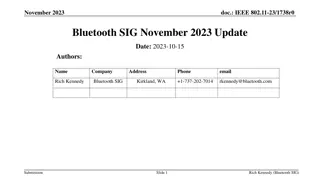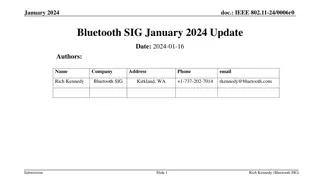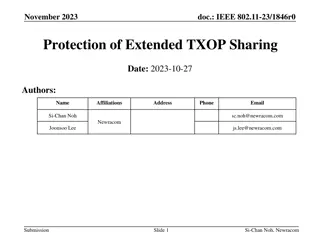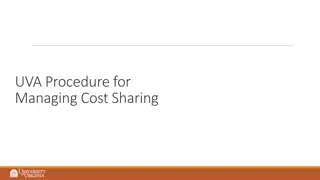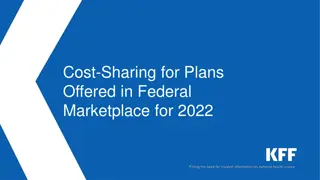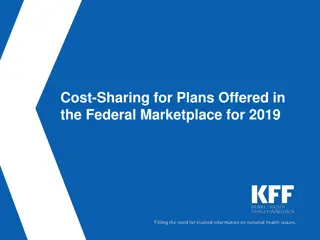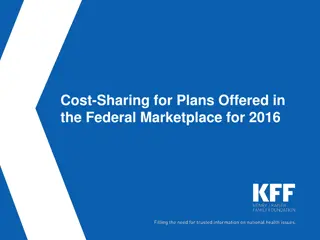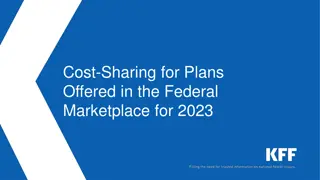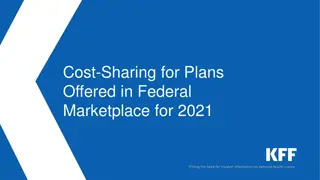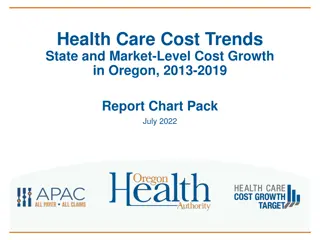Analysis of Cost-Sharing for 2018 Marketplace Health Plans
This analysis delves into cost-sharing aspects of health plans offered in the Federal Marketplace for 2018. It includes figures showing percentages of plans with combined or separate deductibles, along with average medical deductibles categorized by plan type and income levels. The data is sourced from the Kaiser Family Foundation and Healthcare.gov.
Download Presentation

Please find below an Image/Link to download the presentation.
The content on the website is provided AS IS for your information and personal use only. It may not be sold, licensed, or shared on other websites without obtaining consent from the author.If you encounter any issues during the download, it is possible that the publisher has removed the file from their server.
You are allowed to download the files provided on this website for personal or commercial use, subject to the condition that they are used lawfully. All files are the property of their respective owners.
The content on the website is provided AS IS for your information and personal use only. It may not be sold, licensed, or shared on other websites without obtaining consent from the author.
E N D
Presentation Transcript
Cost-Sharing for Plans Offered in the Federal Marketplace for 2018
Figure 1 Percent of Plans Where Medical Deductible is Combined with or Separate from the Prescription Drug Deductible (2018) 100% 8% 90% 80% 41% 56% 58% 70% Separate Combined 60% 50% 92% 40% 30% 59% 44% 42% 20% 10% 0% Bronze Silver Gold Platinum SOURCE: Kaiser Family Foundation analysis of Marketplace plans in the 39 states with Federally Facilitated or Partnership exchanges in 2018 (including Arkansas, New Mexico, Oregon, Kentucky and Nevada). Data are from Healthcare.gov. Health plan information for individuals and families available here: https://www.healthcare.gov/health-plan-information-2018/
Figure 2 Average Medical Deductible, in Plans with Combined Medical and Prescription Drug Deductibles (2018) $7,000 $6,002 $6,000 $5,000 $4,034 $4,000 $3,000 $2,000 $1,194 $1,000 $52 $0 Bronze Silver Gold Platinum SOURCE: Kaiser Family Foundation analysis of Marketplace plans in the 39 states with Federally Facilitated or Partnership exchanges in 2018 (including Arkansas, New Mexico, Oregon, Kentucky and Nevada). Data are from Healthcare.gov. Health plan information for individuals and families available here: https://www.healthcare.gov/health-plan-information-2018/
Figure 3 Average Medical Deductible In Plans with Separate Medical and Prescription Drug Deductibles (2018) $7,000 $5,938 $6,000 $5,000 $3,999 $4,000 $3,000 $2,000 $1,466 $1,000 $350 $0 Bronze Silver Gold Platinum SOURCE: Kaiser Family Foundation analysis of Marketplace plans in the 39 states with Federally Facilitated or Partnership exchanges in 2018 (including Arkansas, New Mexico, Oregon, Kentucky and Nevada). Data are from Healthcare.gov. Health plan information for individuals and families available here: https://www.healthcare.gov/health-plan-information-2018/
Figure 4 Average Medical Deductible In Plans with Combined Medical and Prescription Drug Deductible (2018) $4,500 $4,034 $4,000 $3,500 $2,973 $3,000 $2,500 $2,000 $1,500 $817 $1,000 $500 $234 $0 Silver with no CSR: Incomes over 250% of FPL (over $30,150 for a single individual) Silver, CSR 73% AV: Incomes 200%-250% of FPL ($24,120-$30,150 for a single individual) Silver, CSR 87% AV: Incomes 150%-200% of FPL ($18,090-$24,120 for a single individual) Silver, CSR 94% AV: Incomes 100%-150% of FPL ($12,060-$18,090 for a single individual) SOURCE: Kaiser Family Foundation analysis of Marketplace plans in the 39 states with Federally Facilitated or Partnership exchanges in 2018 (including Arkansas, New Mexico, Oregon, Kentucky and Nevada). Data are from Healthcare.gov. Health plan information for individuals and families available here: https://www.healthcare.gov/health-plan-information-2018/. FPL refers to Federal Poverty Level. CSR refers to Cost-Sharing Reduction. AV refers to Actuarial Value. Income cut-offs are poverty thresholds for a household of one.
Figure 5 Average Medical Deductible In Plans with Separate Medical and Prescription Drug Deductibles (2018) $4,500 $3,999 $4,000 $3,500 $3,112 $3,000 $2,500 $2,000 $1,500 $1,000 $653 $500 $183 $0 Silver with no CSR: Incomes over 250% of FPL (over $30,150 for a single individual) Silver, CSR 73% AV: Incomes 200%-250% of FPL ($24,120-$30,150 for a single individual) Silver, CSR 87% AV: Incomes 150%-200% of FPL ($18,090-$24,120 for a single individual) Silver, CSR 94% AV: Incomes 100%-150% of FPL ($12,060-$18,090 for a single individual) SOURCE: Kaiser Family Foundation analysis of Marketplace plans in the 39 states with Federally Facilitated or Partnership exchanges in 2018 (including Arkansas, New Mexico, Oregon, Kentucky and Nevada). Data are from Healthcare.gov. Health plan information for individuals and families available here: https://www.healthcare.gov/health-plan-information-2018/. FPL refers to Federal Poverty Level. CSR refers to Cost-Sharing Reduction. AV refers to Actuarial Value. Income cut-offs are poverty thresholds for a household of one.
Figure 6 Average Out-Of-Pocket Limit In Plans with Combined Limit for Medical and Prescription Drug Cost Sharing (2018) $8,000 $6,909 $7,000 $6,000 $5,442 $5,000 $4,000 $3,000 $2,039 $2,000 $970 $1,000 $0 Silver with no CSR: Incomes over 250% of FPL (over $30,150 for a single individual) Silver, CSR 73% AV: Incomes 200%-250% of FPL ($24,120-$30,150 for a single individual) Silver, CSR 87% AV: Incomes 150%-200% of FPL ($18,090-$24,120 for a single individual) Silver, CSR 94% AV: Incomes 100%-150% of FPL ($12,060-$18,090 for a single individual) SOURCE: Kaiser Family Foundation analysis of Marketplace plans in the 39 states with Federally Facilitated or Partnership exchanges in 2018 (including Arkansas, New Mexico, Oregon, Kentucky and Nevada). Data are from Healthcare.gov. Health plan information for individuals and families available here: https://www.healthcare.gov/health-plan-information-2018/. FPL refers to Federal Poverty Level. CSR refers to Cost-Sharing Reduction. AV refers to Actuarial Value. Income cut-offs are poverty thresholds for a household of one.




